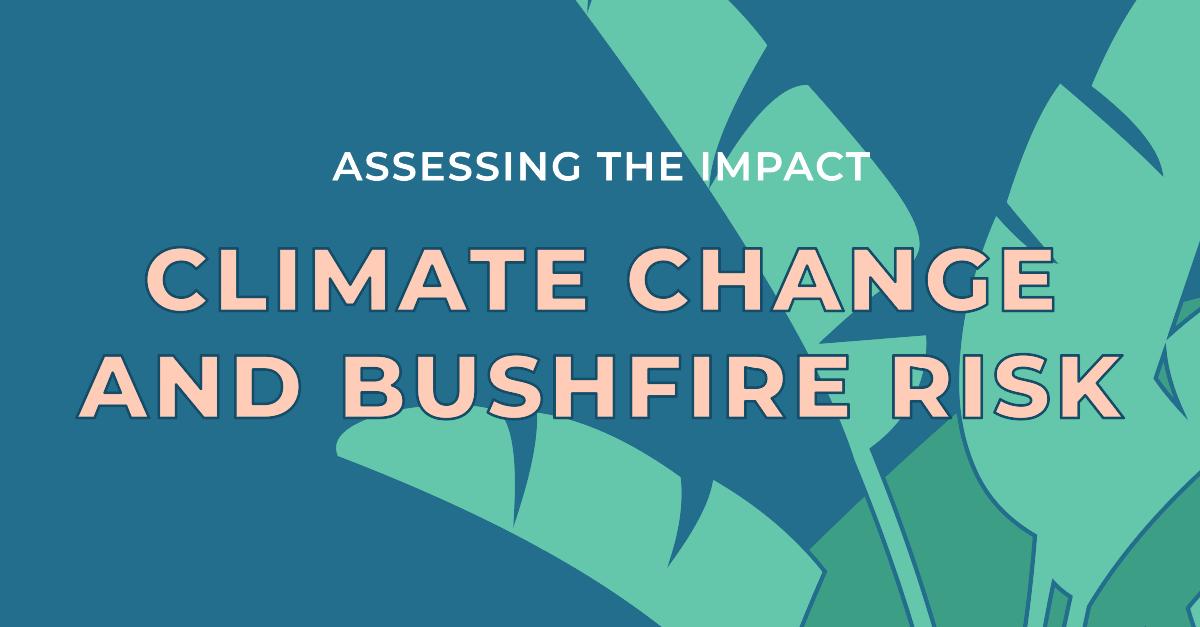Climate change is greatly impacting bushfire risk assessment. Changing weather patterns bring unforeseeable shifts affecting fire likelihood and intensity. Extreme events like heatwaves and droughts increase rapidly spreading fires, requiring adjusted emergency responses. Vegetation changes due to climate alterations impact fire behavior, necessitating controlled burn and fire break strategies. Altered fire dynamics due to reduced fuel moisture levels demand vigilant monitoring and management. Updated data sources are crucial as traditional risk models may underestimate risks. For more insights on how climate change is reshaping bushfire risk assessment, explore further details on various factors influencing this critical assessment process.
Changing Weather Patterns
Experiencing unprecedented shifts in weather patterns requires adapting risk assessment strategies to the changing climate conditions. Weather patterns are increasingly erratic, leading to fluctuations in temperature, rainfall, and wind patterns. These variations can significantly impact the likelihood and intensity of bushfires in your region. It’s crucial to closely monitor these weather changes and adjust your risk assessment approach accordingly.
Moreover, ecosystem changes resulting from altered weather patterns can also influence bushfire risks. Shifts in vegetation, soil moisture levels, and wildlife habitats can all play a role in determining the vulnerability of an area to wildfires. Understanding how these ecosystem changes interact with weather patterns is essential for developing effective bushfire prevention and management strategies.
Increased Frequency of Extreme Events
As weather patterns continue to shift unpredictably, the increased frequency of extreme events poses a growing concern for bushfire risk assessment. These extreme events, such as intense heatwaves, severe droughts, and strong winds, create favorable conditions for rapid fire spread, making it essential to adapt emergency responses and enhance community engagement.
In light of the heightened risk posed by more frequent extreme events, it’s critical to prioritize preparedness and proactive measures. Emergency responses should be well-coordinated, with clear evacuation plans and efficient communication channels to guarantee the safety of individuals in high-risk areas. Community engagement plays a crucial role in fostering resilience and collective action. Encouraging community members to participate in fire safety workshops, establish neighborhood evacuation plans, and maintain defensible spaces around properties can substantially reduce the impact of bushfires.
Impact on Vegetation and Fuel Load
With climate change exacerbating, the impact on vegetation and fuel load is becoming a vital factor in evaluating bushfire risk. Vegetation dynamics play a significant role in determining how fires spread and their intensity. Changes in temperature and rainfall patterns alter the types of plants that grow in an area, affecting fuel load levels. As vegetation composition shifts, some areas may experience an increase in flammable species, leading to higher fire risks.
To mitigate these risks, fire management strategies need to adapt to the evolving vegetation dynamics. Regular monitoring of fuel load levels and vegetation changes is essential for effective fire prevention. Implementing controlled burns in strategic locations can help reduce excess vegetation that acts as fuel for fires. Additionally, creating fire breaks and maintaining them can help slow down the spread of fires, providing firefighters with better opportunities to control them.
Understanding how vegetation dynamics impact fuel load and integrating appropriate fire management strategies are essential steps in addressing the increasing bushfire risk posed by climate change.
Altered Fire Behavior Dynamics
The altered dynamics of fire behavior due to climate change pose significant challenges for bushfire risk assessment and management. As fuel moisture levels decrease, fires ignite more easily, and once ignited, they spread rapidly. This heightened fire spread is a direct result of drier vegetation, making it important to monitor and manage fuel moisture levels effectively.
Understanding how fuel moisture impacts fire behavior is essential for predicting and controlling bushfires. Dry fuel ignites quickly and burns at a faster pace, leading to more intense fires that are harder to contain. By staying informed about fuel moisture conditions in your area, you can better prepare for potential fire threats.
To mitigate the risks associated with altered fire behavior dynamics, it’s important to stay vigilant and follow any fire safety guidelines provided by authorities. Regularly check fuel moisture levels, especially during dry seasons, and take proactive steps to reduce fire hazards around your property. By staying informed and prepared, you can help minimize the impact of changing fire behavior dynamics on bushfire risk assessment and management.
Challenges for Traditional Risk Models
Traditional risk models face significant challenges in adapting to the evolving dynamics of bushfire behavior influenced by climate change. One key challenge is data integration, where traditional models may not effectively incorporate the latest climate data and projections into their risk assessments. This gap in data integration hinders the accuracy of risk evaluations, potentially leading to underestimation of the true bushfire risk. Additionally, the traditional models often rely on historical data that may no longer accurately represent the current and future fire behavior patterns due to climate change-induced shifts.
As a result, relying solely on these outdated risk models for risk assessment could leave you vulnerable to unforeseen bushfire threats. To address these challenges, it’s important to update risk assessment methodologies by integrating the most recent climate data and projections. By incorporating updated data sources, you can enhance the accuracy of risk assessments and better prepare for the increasing bushfire risks posed by climate change.
Importance of Updated Data Sources
To enhance the accuracy of your risk assessments and better prepare for increasing bushfire risks posed by climate change, prioritize integrating updated data sources. Utilizing remote sensing technology can provide real-time information on vegetation health, weather patterns, and fire activity, allowing for more precise risk evaluations.
By incorporating remote sensing data into your predictive modeling, you can identify high-risk areas with greater efficiency and take proactive measures to mitigate potential dangers. Updated data sources offer a holistic view of the changing landscape, enabling you to adapt your strategies accordingly and stay ahead of evolving bushfire threats.
Embracing the latest information through remote sensing and predictive modeling empowers you to make informed decisions that safeguard lives and property. Stay vigilant in monitoring these updated data sources to ensure your risk assessments remain relevant and effective in the face of escalating bushfire risks exacerbated by climate change.
Role of Technology in Assessment
Improving your bushfire risk evaluations through advanced technology can greatly enhance your preparedness and response strategies. Technology advancements play an essential role in ensuring the accuracy of data used in evaluating bushfire risks.
By utilizing cutting-edge tools such as satellite imaging, drones, and sophisticated modeling software, you can gather real-time information about vegetation density, weather patterns, and topographical features. These technological innovations provide you with a more thorough understanding of your surroundings, enabling you to identify high-risk areas with greater precision.
Moreover, the use of advanced technology allows for the integration of historical data and predictive analytics, helping you anticipate potential fire outbreaks before they occur. By harnessing the power of these tools, you can proactively implement preventive measures and allocate resources effectively.
Ensuring data accuracy through technology not only enhances the reliability of your risk evaluations but also empowers you to make well-informed decisions to protect lives and property in the face of escalating bushfire threats.
Community Resilience and Preparedness
Improving community resilience and preparedness is essential in lessening the impact of bushfires. To enhance resilience, communities can implement various strategies.
First, fostering community engagement is key. Encouraging neighbors to work together, participate in drills, and share resources strengthens the community’s ability to respond effectively when a bushfire strikes. Additionally, organizing training sessions on evacuation procedures and fire safety measures can empower individuals to take swift and appropriate action during emergencies.
Creating a community emergency plan that outlines roles, responsibilities, and communication channels is critical for coordinated responses. Identifying vulnerable members within the community and establishing support systems for them is equally important. Regularly reviewing and practicing these plans ensures readiness when needed most.
Collaborative Approaches for Mitigation
Collaborative efforts among stakeholders play an important role in mitigating bushfire risks and enhancing overall preparedness. Community engagement is key in this process. By working together with local residents, authorities, and organizations, you can create a more resilient community.
Encouraging participation in risk communication initiatives is vital. Make sure to stay informed about bushfire risks in your area and share this information with your neighbors. Establishing communication channels within the community can help disseminate important updates and warnings effectively. When everyone is involved and aware, the community becomes better prepared to face potential bushfire threats.
Policy Implications for Future Planning
When considering policy implications for future planning in bushfire risk assessment, focus on integrating community feedback and scientific research to develop robust strategies. Engaging with local residents, firefighters, and experts can provide valuable insights into the specific needs and challenges faced in different regions. By incorporating community feedback, policymakers can tailor future strategies to address the unique circumstances of each area, enhancing overall preparedness and response efforts.
In addition to community input, it’s essential to prioritize adaptation measures based on the latest scientific research. Understanding how climate change is influencing bushfire behavior and patterns is vital for developing effective strategies to mitigate risks. By staying informed about emerging research findings, policymakers can make informed decisions that align with the most up-to-date knowledge.
Conclusion
To sum up, the impact of climate change on bushfire risk assessment is nothing short of a fiery inferno. With changing weather patterns, increased extreme events, and altered fire behavior dynamics, traditional risk models are facing a blazin challenge.
Technology, community resilience, and collaborative mitigation efforts are like water in the scorching heat, providing some relief.
Policy implications for future planning must address this burning issue before it engulfs us all in its relentless flames.

















































































0